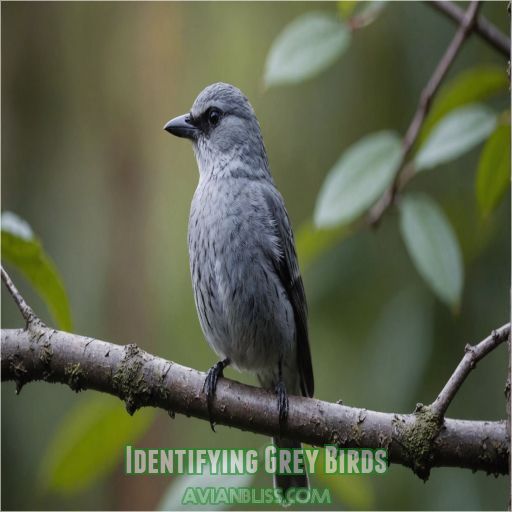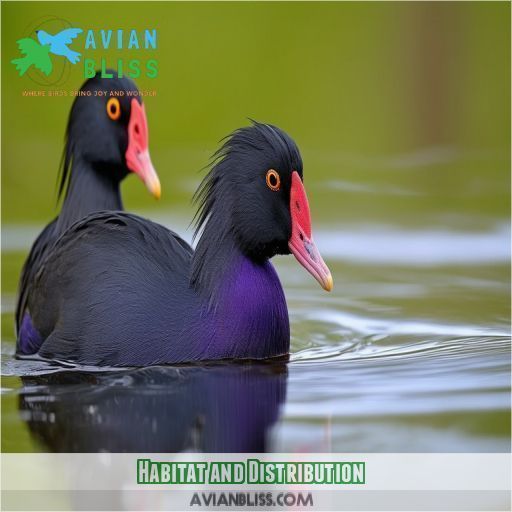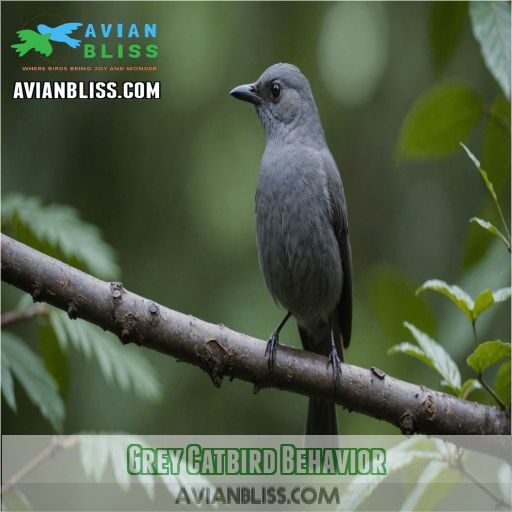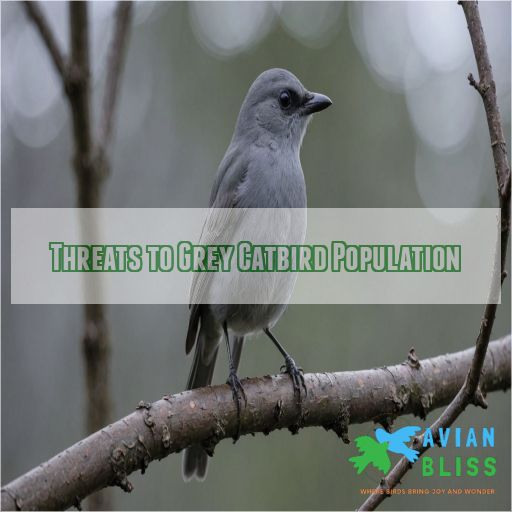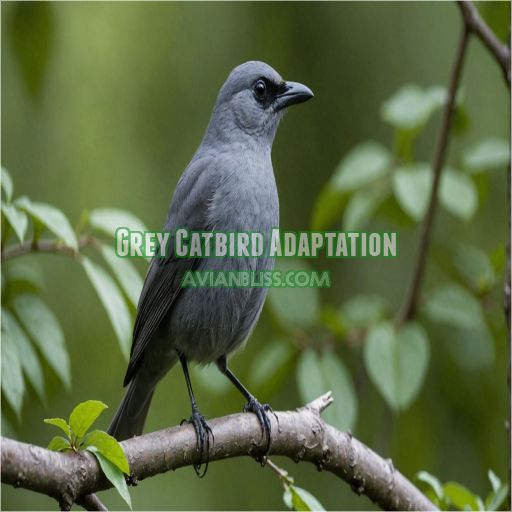This site is supported by our readers. We may earn a commission, at no cost to you, if you purchase through links.

These stealthy feathered friends can be tricky to spot, but once you learn to recognize their unique features, you’ll be spotting them left and right.
From the sassy grey catbird with its "meow" call to the bold mockingbird with its flashy wing patches, these birds have so much personality.
And get this – they’re masters of disguise, blending seamlessly into their surroundings.
But don’t worry, I’ve got all the tips and tricks to help you become a grey and black bird expert.
Ready to get started?
Table Of Contents
- Key Takeaways
- Identifying Grey Birds
- Grey and Black Bird Species
- Grey Catbird Profile
- Distinguishing Grey Catbirds
- Habitat and Distribution
- Grey Catbird Behavior
- Threats to Grey Catbird Population
- Grey Catbird Migration
- Grey Catbird Adaptation
- Conserving Grey Catbirds
- Frequently Asked Questions (FAQs)
- What kind of bird is black and gray?
- What is the difference between a northern mockingbird and a GREY catbird?
- Are Gray Catbirds rare?
- What does a gray catbird look like?
- What are the nesting habits of Black Phoebes?
- How can I attract Black-capped Chickadees?
- What are the distinguishing features of Northern Mockingbirds?
- How do Black-capped Chickadees forage for food?
- What is the diet of the Northern Mockingbird?
- Conclusion
Key Takeaways
- You’ll be amazed by the clever disguises of grey and black birds – they can blend seamlessly into their surroundings, making them a fun challenge to spot and identify.
- Get to know the unique personalities of grey birds, such as the sassy grey catbird and the bold northern mockingbird – their charming behaviors and impressive vocal abilities will delight you.
- Dive into the fascinating world of grey bird families, from the rock-star chickadees to the elusive gnatcatchers, and learn how to recognize their distinctive features and habitats.
- Become a grey and black bird conservation hero by creating a backyard oasis with native plants and feeders – you’ll attract these feathered friends and help protect their populations.
Identifying Grey Birds
If you’ve ever wondered about the gray birds flitting through your backyard, you’re in good company—it’s a common challenge for bird enthusiasts.
With a few tips on identifying these elusive creatures known for their gray plumage, you might become the Sherlock Holmes of birdwatching.
Overview of Grey Bird Species
Identifying grey birds can be a delightful challenge for birders of all levels.
From the charcoal-hued chickadees to the slate-colored juncos, these feathered friends come in a variety of shades.
While their plumage may initially seem drab, a closer look reveals the nuanced beauty of these adaptable avians.
Embrace the grey and discover the fascinating world of these understated yet intriguing birds.
Common Grey Bird Families
Starting out with birdwatching? You’ll often encounter chickadees, thrushes, vireos, and gnatcatchers – the rock stars of gray bird families.
They might seem like feathered ninjas blending into the shadows, but with practice, you’ll spot their unique songs and habitats.
Understanding these gray bird crusaders gives you the power to identify, admire, and conserve our charming, avian companions.
Characteristics of Grey Plumage
As you explore grey bird families, notice how grey plumage can change with light.
This variation makes identifying bird types exciting yet tricky, especially when it comes to distinguishing between similar species like the Snowy Egret and the Cattle Egret. types of white birds.
Melanism can darken feathers, adding a black hue.
It’s like a bird’s fashion choice, influenced by age and sex, leading to unique bird characteristics.
Understanding these bird features is key for spotting those elusive grey and black birds.
Grey and Black Bird Species
When you’re out birdwatching, you’ll come across numerous birds that seem to blend shades of gray and black, making them a fun challenge to identify.
Don’t worry if you mix up a Gray Catbird with a Northern Mockingbird; even seasoned birders have their moments of mistaken identity!
List of Birds That Appear Grey
Gray birds come in all shapes and sizes, from the familiar chickadees to the lesser-known gnatcatchers.
Whether you’re a seasoned birder or just starting out, keep an eye out for these feathered friends – you never know what hidden gems you might spot flitting through the trees or perched on a nearby branch like the White-Breasted Nuthatch.
Common Grey and Black Bird Families
If you’re looking for birdwatching tips, certain bird families offer a treasure trove of gray and black backyard birds.
Chickadees, thrushes, and vireos beckon with charm and subtlety.
Engage in bird identification by observing their behaviors and noting their bird calls and songs, like the distinctive calls of the Boat-Tailed Grackle.
Their subtle hues and melodious tunes weave a tapestry of life’s wonders, inviting exploration and discovery.
Examples of Grey and Black Birds
Spotting grey and black birds can be thrilling!
Keep an eye out for the Black-capped Chickadee, known for its charming antics and distinctive call.
Grey Flycatchers flutter gracefully through open woodlands, while Grey Catbird sightings reward you with mimicry magic.
Fly with curiosity!
Grey Catbird Profile
You’ll find the Grey Catbird’s sleek slate-gray body, charming black cap, and rusty under-tail coverts make it stand out in any backyard.
Though they might be the gray ghost of your garden, known for their peculiar mewing call, they’re also master foragers and devoted nest builders.
Physical Characteristics of Grey Catbirds
You’ll instantly recognize a Gray Catbird by its slate-gray plumage, black cap, and chestnut-colored undertail coverts.
At around 8-1/2 inches long with an 11-inch wingspan, these songbirds are medium-sized.
Their expressive tail-flicking and cat-like "meow" calls are also telltale signs.
Whether perched atop a shrub or flitting through the foliage, Gray Catbirds are a delight to observe.
Grey Catbird Diet and Foraging Habits
With a slate-grey presence and a beak full of mystery, your charming grey catbird, Dumetella carolinensis, loves a mixed menu.
Hunting bugs like beetles and caterpillars, or savoring juicy berries, they’re like chefs in the avian world.
To entice them, offer grape jelly at bird feeders.
These mimic thrushes adapt well, keeping food fresh no matter the season!
Grey Catbird Nesting and Breeding Habits
Grey catbirds build nests with twigs and leaves in dense shrubs or vines, perfect for “feathering the nest.”
These skilled architects lay four eggs per brood, with diligent parental care ensuring survival.
Bird conservation is critical; the catbird’s unique nesting habits are a keystone in bird ecology. Capture their charm in nature’s frame—not just in animal photography or wallpaper.
Distinguishing Grey Catbirds
To tell the charming Gray Catbird apart from other gray and black birds, focus on its slate-gray body and unique cat-like call.
You’ll soon see how they stand out, just don’t confuse them with their impersonating cousins, the Northern Mockingbirds!
Grey Catbird Identification Features
Two key features distinguish the grey catbird from other grey birds – its distinctive black cap and rust-colored undertail coverts. Like a Black-headed Grosbeak.
Slightly smaller than a robin, the catbird is known for its expressive tail-flicking and cat-like "meow" call.
Observing these unique traits can help you confidently identify this charismatic backyard visitor.
Comparison With Northern Mockingbirds
As you’re identifying gray catbirds, song mimicry might leave you scratching your head—it’s a common trait they share with their cousin, the Northern Mockingbird.
But, unlike catbirds, mockingbirds have bold white wing patches and love showing off their acrobatics.
While these two share habitat overlap, territorial behavior and nesting differences make telling them apart a breeze.
Differences Between Male and Female Grey Catbirds
When considering plumage differences, male and female gray catbirds are like identical twins—you can’t tell them apart. Both wear the same slate-gray suit with a hint of rust-red.
Yet, watch them closely during nesting season as their breeding behavior reveals distinct roles: 1. Nest building. 2. Vocalizations. 3. Egg care. 4. Food sharing.
Aren’t they fascinating?
Habitat and Distribution
You’ll find Gray Catbirds flitting through various habitats like woodlands, shrublands, and urban gardens, where they love exploring for insects and berries.
They’re the ultimate travel enthusiasts—these adventurous birds migrate to warmer areas during winter, proving that even birds need a vacation sometimes!
Range and Distribution of Grey Catbirds
The gray catbird’s range stretches across the eastern United States, from Maine to Florida and as far west as the Rockies.
These migratory songbirds spend their summers in the north and migrate south for the winter, often wintering in the southern U.S. or the Caribbean.
Keep an eye out for their distinctive gray plumage and cat-like calls in your local parks and backyards!
Common Habitats of Grey Catbirds
You’ve explored where grey catbirds can be found; now let’s talk habitats! These adaptable birds love various settings.
They prefer:
- Dense shrubs and thickets for nesting.
- Woodland edges and forests for cover.
- Gardens and backyards, especially with berry bushes.
- Urban areas, showing remarkable tolerance for city life.
Who’d have thought our feathery friends could be such urbanites?
Migration Patterns of Grey Catbirds
Imagining the journey of Gray Catbirds feels a bit like planning a road trip.
Their migration timing kicks off in fall, leaving breeding grounds in the north, heading to cozy wintering areas in the south.
They follow flight paths, making pit stops at stopover sites.
These well-planned routes showcase their clever navigation, highlighting nature’s impressive GPS system!
Grey Catbird Behavior
When you observe a Gray Catbird, you’re witnessing a bird full of personality, from its curious foraging habits to its peculiar mewing call.
Imagine a feathery mimic comedian, engaging other birds with its wide range of sounds while mischievously swiping berries from your garden.
Foraging and Feeding Habits
As a ground forager, the gray catbird flips leaves aside with its bill to uncover tasty insects like beetles, ants, and caterpillars.
But don’t be fooled – these birds also have quite the sweet tooth, relishing wild berries and even indulging in grape jelly at backyard feeders!
Their diverse diet helps them thrive in various habitats.
Social Behavior and Interaction
When observing a gray catbird’s social behavior, you’ll notice their flair for interaction. They exhibit:
- Flocking: Often found in small groups, showcasing their social nature.
- Territoriality: Fiercely protective, these birds know how to claim their turf!
- Mating Rituals: Singing love songs with fervor, they know how to woo.
- Communication & Aggression: Smart communicators, yet feisty when ruffled.
Alarm Calls and Warning Signs
You’re not the only one eavesdropping on social interactions!
When gray catbirds get chatty, they’re signaling more than a backyard party.
These mimicry pros use bird language for survival signals and territorial defense, alerting pals of lurking predators.
Curious about their calls?
Explore how they differentiate alarms in various situations:
| Signal Type | Sound |
|---|---|
| Alert | Mewing |
| Predator Nearby | Sharp chirps |
| Safe to Proceed | Gentle notes |
| Territorial | Aggressive song |
Threats to Grey Catbird Population
You might think grey catbirds lead an idyllic bird life, but they’re not immune to modern threats.
Climate change, habitat destruction, and urbanization could turn their bird world upside down!
Climate Vulnerability of Grey Catbirds
The Gray Catbird’s future may be uncertain as climate change poses a potential threat.
Scientists are closely monitoring how rising temperatures and shifting weather patterns could impact the bird’s range and population.
While the species seems to be faring well for now, conservationists remain vigilant to protect the Gray Catbird’s survival in the years ahead.
Potential Threats From Habitat Destruction
Imagine you’re a bird and suddenly, your favorite tree’s gone due to deforestation. Sounds like a nightmare, right?
Habitat destruction, fueled by urban sprawl and pollution, threatens Gray Catbirds.
Climate change and invasive species stir the pot too.
It’s a jigsaw puzzle of challenges, and we’ve got to piece it together to protect their survival.
Effects of Urbanization on Grey Catbirds
Urban sprawl isn’t just your morning commute headache; it can be a gray catbird’s nightmare. Imagine facing urban noise and habitat loss in search of dwindling food sources and scarce nest sites. With competition increasing, stress levels soar for these resilient singers. By understanding and addressing these challenges, you can help maintain a harmonious world where catbirds continue to thrive.
Grey Catbird Migration
If you’ve ever wondered where gray catbirds go during the colder months, you’re about to set off on a fascinating journey of discovery!
These stealthy little birds make impressive migrations, often covering long distances, and they rely on specific staging grounds as pit stops along the way.
Seasonal Migration Patterns
As the seasons change, grey catbirds set off on their remarkable migratory journeys.
These songbirds depart their breeding grounds in the north, heading south to their wintering havens, often in the southern United States or the tropics.
Their internal compass guides them through the skies, a remarkable feat of avian navigation.
Distance and Routes of Grey Catbird Migration
The timing of Gray Catbird migration is a rhythmic dance with nature, as these birds journey vast distances twice a year.
During fall, they travel from breeding grounds in North America to winter ranges in the southern U.S. and tropics.
Spring migration sees them retrace their steps, heading north with palpable anticipation, their calls a melodious reminder of the warmer days ahead.
Staging Grounds for Migrating Grey Catbirds
Spotting a gray catbird amidst its migration isn’t just about timing.
It’s like catching that perfect wave—habitat preferences and food sources play key roles.
These birds frequent dense shrubs for staging grounds.
Keep an eye out, as threats faced by catbirds can impact these important stopovers.
Conservation efforts help make sure they’ve safe havens along their journey.
Grey Catbird Adaptation
You’ll discover that Gray Catbirds, with their sneaky little mews, are experts in blending sound with silence, making them masters of all things sneaky in the backyard.
Observe how these birds, like mischievous neighbors, adapt to diverse environments, coexisting peacefully with other feathery residents.
Unique Characteristics and Abilities
Remarkably, the grey catbird possesses a unique ability to mimic the calls of other birds, from the melodic songs to the cat-like mews that earned them their name.
This vocal virtuosity allows them to communicate with their feathered neighbors and stand out in the chorus of the backyard symphony.
Behavioral Adaptations of Grey Catbirds
Unraveling the secrets of Grey Catbirds, you’ll find their smart nest building and foraging tricks fascinating.
Mastering mimicry, their vocalizations echo the tunes of other songbirds, adding zest to social interactions.
Whether they’re imitating melodies or rummaging for food, Grey Catbirds showcase impressive adaptability.
Like a skilled actor, they capture nature’s calls and turn a simple meal into a gourmet adventure.
How Grey Catbirds Coexist With Other Bird Species
When it comes to sharing their turf, gray catbirds don’t play the lone ranger.
They coexist with other birds by wisely managing competition and territory.
Catbirds are savvy negotiators, utilizing interspecies relations to share food sources.
They’re like good neighbors, adjusting nesting habits to make sure everyone’s got room.
It’s all about balance and knowing when to respect another bird’s perch!
Conserving Grey Catbirds
Protecting Gray Catbirds is important because these delightful songsters play key roles in the ecosystem by controlling insect populations and dispersing seeds.
You can help by preserving their habitats, perhaps starting with a berry bush or two—just don’t be surprised if they sing you a thank-you song!
Why Grey Catbird Conservation is Important
The humble Grey Catbird plays a vital role in our local ecosystems. As an insect-eating songbird, it helps control pest populations and supports plant health.
Plus, these charismatic birds delight birdwatchers with their melodic calls.
Conserving Grey Catbirds is important to:
- Maintain ecological balance
- Protect biodiversity
- Enhance birdwatching opportunities
- Inspire environmental stewardship
How to Support and Conserve Grey Catbird Habitats
Native plants are your secret weapon in combating habitat loss for Gray Catbirds.
Imagine transforming your backyard garden into a catbird paradise.
Planting berry-producing shrubs and trees provides food, while catbird feeders offer a bird buffet.
Join citizen science projects to track their journeys.
By supporting our feathered friends, you’ll bring harmony to your slice of nature.
Partnerships and Programs for Protecting Grey Catbird Populations
Joining conservation efforts is like a beacon of hope for safeguarding gray catbird populations.
Get involved with habitat restoration projects, participate in citizen science initiatives, or lend a hand in bird banding and nest monitoring.
These actions help birds but also connect you with nature, empowering your control over environmental impact.
Let’s keep those songbirds singing!
Frequently Asked Questions (FAQs)
What kind of bird is black and gray?
They say, "a bird in the hand is worth two in the bush."
Look out for Gray Catbirds, which often appear black due to lighting.
They sport a slate-gray body, black cap, and chestnut undertail.
What is the difference between a northern mockingbird and a GREY catbird?
Spotting the difference between a Northern Mockingbird and a Grey Catbird is easy when you know this: Mockingbirds sport white wing patches and replicate other bird songs, while Catbirds are gray with a rusty undertail and mew.
Are Gray Catbirds rare?
Are Gray Catbirds rare? Hardly! These feisty songbirds are a common sight across the eastern United States.
With their distinctive mewing calls and adaptable nature, they’re a delight to spot in your backyard.
Why not keep an eye out for these charismatic gray birds?
What does a gray catbird look like?
Imagine a sleek ninja in the bird world—a gray catbird brandishes slate-gray attire, a black cap, and rust-red under-tail feathers.
It’s the size of a robin, blending in yet standing out with its cat-like mew.
What are the nesting habits of Black Phoebes?
Picture the Black Phoebe as an architect carefully crafting its mud nest.
You’d find these nests, like stubborn barnacles, clinging to walls and overhangs near water, blending into human structures with an unyielding tenacity .
How can I attract Black-capped Chickadees?
To attract Black-capped Chickadees, set up a cozy feeder with sunflower seeds or suet.
Offer them a birdhouse in a safe spot.
By planting native trees and shrubs, you’ll make them feel right at home.
What are the distinguishing features of Northern Mockingbirds?
You can’t miss the Northern Mockingbird’s striking gray plumage, bold white wing patches, and long, slender tail.
Its energetic hops and mimicry of other birds’ songs make it a delightful backyard companion.
How do Black-capped Chickadees forage for food?
Black-capped Chickadees forage by flitting energetically, like tiny ninjas, through trees, inspecting branches for insects and seeds.
Their curiosity drives them to explore every nook, storing food for winter in secret caches only they recall.
What is the diet of the Northern Mockingbird?
Picture the Northern Mockingbird as nature’s DJ, sampling a wide buffet—berries, fruits, insects, and even the odd lizard.
It’s a smorgasbord that sustains their melodious mimicry and keeps them energetically flitting about.
Conclusion
Ah, the adventure of identifying grey and black birds! It’s like a quirky hobby where you’ll become the Sherlock Holmes of the avian world.
Armed with your newfound knowledge, you’ll easily spot these elusive creatures in the wild.
Understanding their behaviors and habitats lets you appreciate their unique charms while actively contributing to conservation efforts.
Enjoy the journey!

